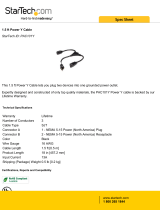
Varian,Inc.
2700 Mitchell Drive
Walnut Creek, CA 94598 U.S.A.
03-914961-00:6 1 of 24 1200/1200L MS Pre-installation Instructions
1200/1200L GC/MS and LC/MS
Pre-installation Instructions
Congratulations on your purchase of the Varian 1200 Quadrupole Mass Spectrometer. The
information provided in this pre-installation guide will help you prepare your installation site for
your Varian 1200 GC/MS, 1200L GC/MS, 1200L LC/MS, or 1200L GC/LC/MS system. Use the
general requirements and the appropriate section of these pre-installation instructions as a
guide while preparing the installation site. When your site meets all the requirements detailed
in these instructions, contact the Customer Service office in your region to schedule installation.
The Varian 1200L LC/MS and 1200/1200L GC/MS have been designed to operate reliably
under carefully controlled environmental conditions. It is the responsibility of the customer to
provide a suitable location, power source, and operating environment. Operating or maintaining
a system in operational conditions outside of the power and operating environment limits
described in this manual could cause failures of many types. The repair of such failures is
specifically excluded from the Warranty and Service contract conditions.
CAUTIO
All phases of the installation site preparation must conform to
local safety, electrical, and building codes. These codes take
precedence over any recommendations in these instructions,
and compliance to them is the responsibility of the customer.
General Requirements.................................................. 2
Operating Environment ........................................... 2
Temperature/Humidity............................................. 2
Particulate Matter .................................................... 2
Vibration .................................................................. 2
Exhaust System ...................................................... 2
1200 GC/MS.................................................................3
Entrance.................................................................. 3
Space and Load Requirements............................... 3
Power Requirements 1200 GC/MS.........................4
Gas Requirements 1200 GC/MS ............................ 5
1200L GC/MS...............................................................6
Entrance.................................................................. 6
Space and Load Requirements............................... 6
Power Requirements 1200L GC/MS.......................7
Gas Requirements 1200L GC/MS .......................... 8
1200L LC/MS.............................................................. 10
Entrance................................................................ 10
Space and Load Requirements ............................ 10
Power Requirements 1200L LC/MS...................... 11
Gas Requirements 1200L LC/MS ......................... 12
Solvent Requirements 1200L LC/MS.................... 13
1200L GC/LC/MS ....................................................... 13
Entrance................................................................ 13
Space and Load Requirements ............................ 13
Power Requirements 1200L GC/LC/MS ............... 14
Gas Requirements 1200L GC/LC/MS................... 15
Solvent Requirements 1200L LC/MS.................... 18
Instrument Arrival ....................................................... 19
Inspection.............................................................. 19
Unpacking and Installation.................................... 20
Spare Parts ........................................................... 20
Preventive Maintenance ....................................... 20
Appendix 1. Module Specifications............................ 21
Appendix 2. Power Consumption .............................. 22
Appendix 3. NEMA Plugs and Power Outlets............ 24





















